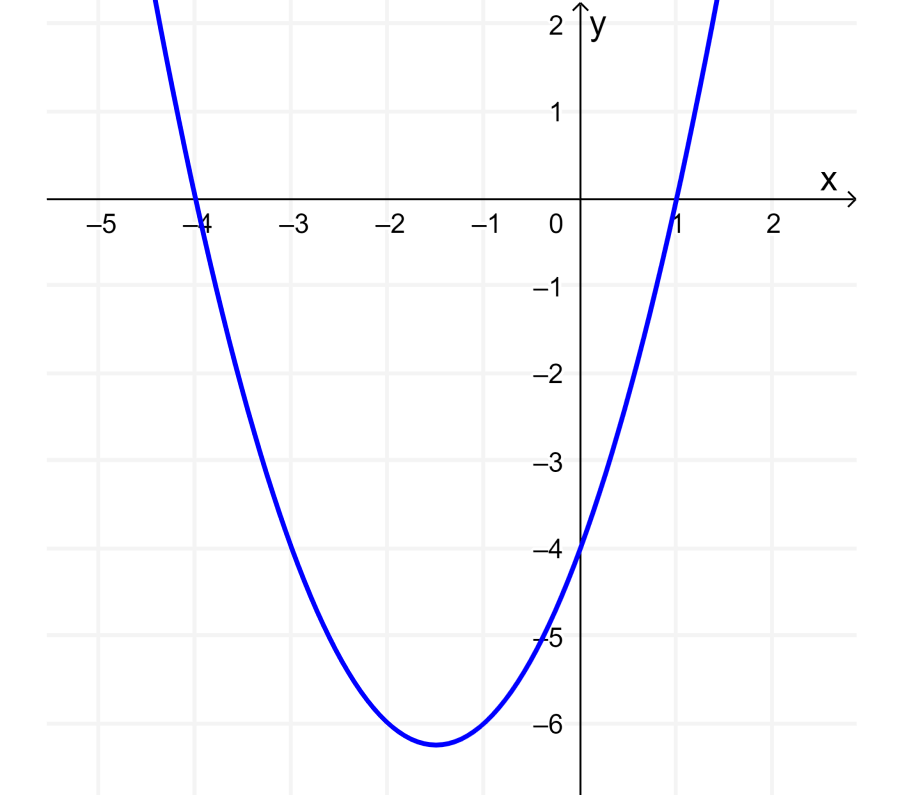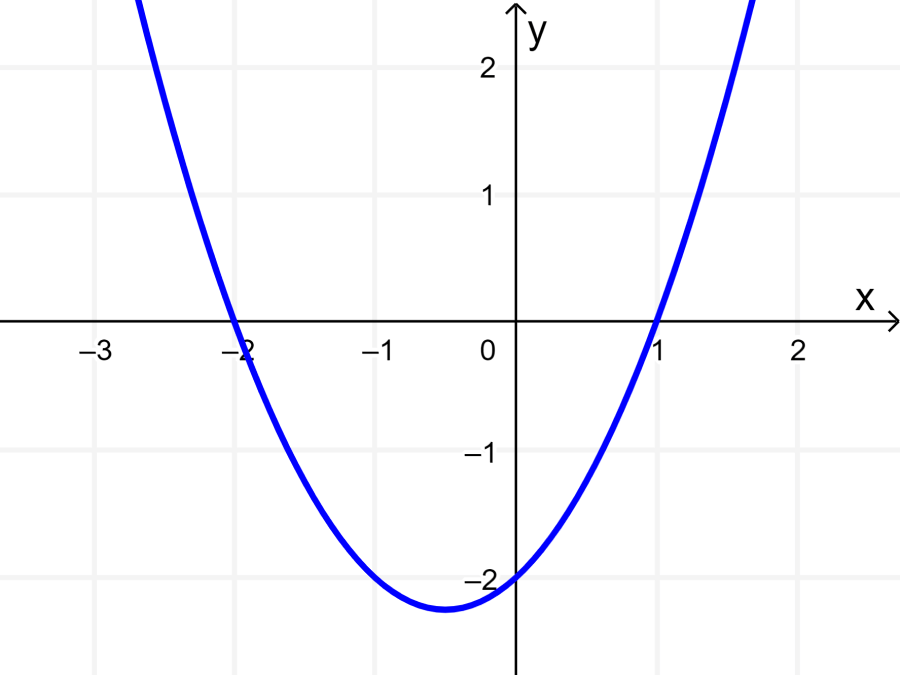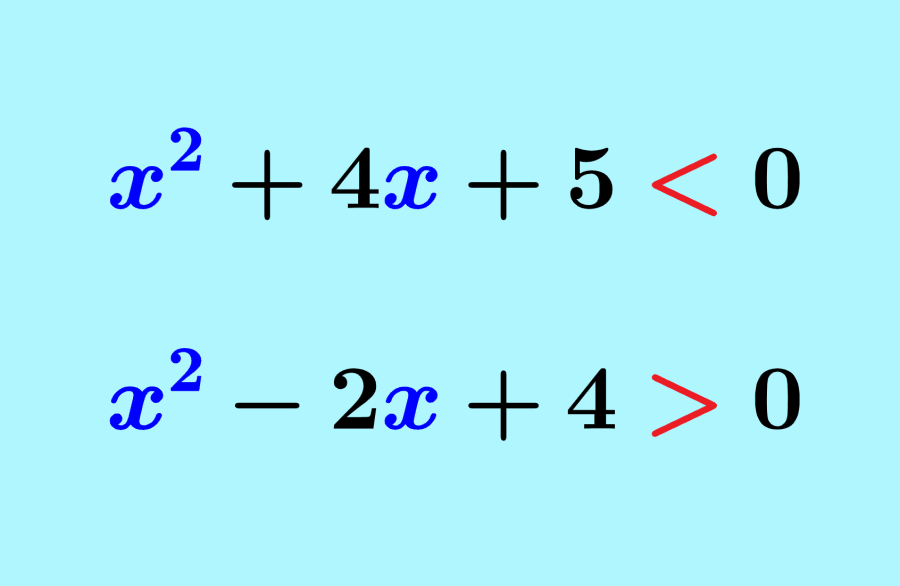Quadratic inequalities have the form ax²+bx+c>0, where the inequality signs used are <, >, ≤ and ≥. To solve quadratic inequalities, we have to find the values of x in the equation ax²+bx+c=0, and then determine the inequality signs those values have to use for the original inequality to be correct.
In this article, we will learn all about quadratic inequalities. We will learn how to solve them, and we will apply what we have learned in some practice problems.
How to solve quadratic inequalities
To solve quadratic inequalities, we can follow the following steps:
Step 1: Simplify and write the inequality in the form $latex ax^2+bx+c<0$. The “<” sign could be different depending on the problem.
Step 2: Identify where the graph of $latex y=ax^2+bx+c$ intersects the x-axis. To achieve this, we can solve the quadratic equation by factoring $latex ax^2+bx+c=0$ and find the x values.
Step 3: Sketch a simple graph of the function $latex y=ax^2+bx+c$ to determine the solution. Alternatively, we can solve without a graph by considering the following:
- If we have a positive quadratic term, the parabola opens up and is U-shaped.
- If the quadratic term is negative, the parabola opens down.
- Values below the x-axis are less than 0, and values above the x-axis are greater than 0.
Step 4: Using the graph or otherwise, we need to determine the inequality symbols that will make the solutions found in step 2 satisfy the inequality.
Explore the examples with answers shown below to understand the application of these steps with real problem
10 Examples of quadratic inequalities with answers
Each of the following examples has its respective detailed solution. However, try to solve the problems yourself before looking at the answer.
EXAMPLE 1
Solve the inequality $latex x^2+3x-4<0$.
Solution
To solve the inequality, we need to find the roots of the equation $latex x^2+3x-4=0$. We can achieve this using factorization:
$latex x^2+3x-4=0$
$latex (x+4)(x-1)=0$
$latex x=-4~~$ or $latex ~~x=1$
Now, we can sketch a graph to facilitate the resolution of the problem:

We have the inequality $latex x^2+3x-4<0$, which tells us that we need the part that has values less than 0. That is, we need the part that is below the x-axis.
Using the graph, we can deduce that this happens when $latex -4<x<1$.
EXAMPLE 2
Find the solution to the inequality $latex x^2+x-2>0$.
Solution
To solve the inequality, we need to start by finding the values of x in the equation $latex x^2+x-2=0$. Therefore, we can use factorization:
$latex x^2+x-2=0$
$latex (x+2)(x-1)=0$
$latex x=-2~~$ or $latex ~~x=1$
The parabola formed by the equation $latex y=x^2+x-2$ opens up and is U-shaped because the quadratic term is positive:

The inequality $latex x^2+x-2>0$ indicates that the values are always greater than 0. Using the graph, we can deduce that this happens when $latex x<-2~$ or $latex ~x>1$.
EXAMPLE 3
Solve the inequality $latex x^2+2x-8<0$.
Solution
We need to find the values of x in the equation $latex x^2+2x-8=0$. We can achieve this using factorization:
$latex x^2+2x-8=0$
$latex (x+4)(x-2)=0$
$latex x=-4~~$ or $latex ~~x=2$
Let’s solve without using the graph. For this, we have to consider that since the quadratic term is positive, the parabola formed by $latex y=x^2+2x-8$ will open up.
Now, the inequality $latex x^2+2x-8<0$ indicates that we need only the values that are less than 0, that is, the part that is below the x-axis. This happens when $latex -4<x<2$.
EXAMPLE 4
Find the solution to the inequality $latex x^2+8x+4>2x-4$.
Solution
We start by simplifying as follows:
$latex x^2+8x+4>2x-4$
$latex x^2+6x+8>0$
Now, we can form the equation $latex x^2+6x+8=0$ and solve by factoring:
$latex x^2+6x+8=0$
$latex (x+4)(x+2)=0$
$latex x=-4~~$ or $latex ~~x=-2$
The inequality $latex x^2+6x+8>0$ means that the values are always greater than 0. This means that we need the part of the parabola that is above the x-axis.
Since the parabola opens up (the quadratic term is positive), the solution to the inequality is $latex x<-4~$ or $latex ~x>-2$.
EXAMPLE 5
Solve the inequality $latex x^2+2x-12<x+8$.
Solution
We can combine like terms and write the inequality in the form $latex ax^2+bx+c<0$:
$latex x^2+2x-12<x+8$
$latex x^2+x-20<0$
We can find the values of x by forming the equation $latex x^2+x-20=0$ and solve by using factorization:
$latex x^2+x-20=0$
$latex (x+5)(x-4)=0$
$latex x=-5~~$ or $latex ~~x=4$
Now, we need to find the values of x that make $latex x^2+x-20<0$ always have values less than 0. This means we need the part below the x-axis.
Since the parabola opens up (the quadratic term is positive), the parabola is below the x-axis when the values of x are greater than -5 and less than 4, that is, $latex -5<x<4$.
EXAMPLE 6
What is the solution to the inequality $latex x^2+4x+10>-4x-5$?
Solution
Simplifying the inequality, we get the following:
$latex x^2+4x+10>-4x-5$
$latex x^2+8x+15>0$
Now, we can form the equation $latex x^2+8x+15=0$ and solve it by factoring:
$latex x^2+8x+15=0$
$latex (x+5)(x+3)=0$
$latex x=-5~~$ or $latex ~~x=-3$
To solve the inequality $latex x^2+8x+15>0$, we have to find the values of x that always produce values greater than 0 (above the x-axis).
Since the parabola opens up, the solution to the inequality is $latex x<-5~$ or $latex ~x>-3$.
EXAMPLE 7
Solve the inequality $latex -x^2+6x-8\geq 0$.
Solution
Here, we have a quadratic term that is negative. We can make it easier to solve the inequality by multiplying the entire inequality by -1 to make the quadratic term positive:
$latex x^2-6x+8\leq 0$
Note: Keep in mind that when multiplying or dividing the inequality by a negative sign, we have to flip the inequality sign.
Now, we form the equation $latex x^-6x+8=0$ and solve by factoring to find the values of x:
$latex x^2-6x+8=0$
$latex (x-4)(x-2)=0$
$latex x=4~~$ or $latex ~~x=2$
To solve the inequality $latex x^2-6x+8\leq 0$, we have to look for the values of x that produce values less than or equal to 0. Therefore, we look for the portion of the parabola below the x-axis.
The solution is $latex 2\leq x\leq 4$.
EXAMPLE 8
Find the solution to the inequality $latex -2x^2+9x-10\leq 0$.
Solution
Again, we can multiply the entire inequality by -1 to make it easier to solve:
$latex 2x^2-9x+10\geq 0$
Note: The inequality sign was changed since we multiplied by a negative sign.
Now, we solve the equation $latex 2x^-9x+10=0$:
$latex 2x^2-9x+10=0$
$latex (2x-5)(x-2)=0$
$latex x=\frac{5}{2}~~$ or $latex ~~x=2$
The inequality $latex 2x^2-9x+10\geq 0$ indicates that we need the values of x that produce values greater than or equal to 0. Thus, we look for the portion of the parabola above the x-axis.
The solution is $latex x\leq 2~~$ or $latex ~~x\geq \frac{5}{2}$.
EXAMPLE 9
Solve the inequality $latex \frac{2}{x-3}\leq 1$.
Solution
Let’s multiply the entire inequality by $latex (x-3)^2$ to get rid of the fraction and make sure the inequality is positive
$latex 2(x-3)\leq 1(x-3)^2$
$latex 2x-6\leq x^2-6x+9$
$latex 0\leq x^2-8x+15$
$latex x^2-8x+15\geq 0$
We solve the equation $latex x^2-8x+15=0$ by factoring:
$latex x^2-8x+15=0$
$latex (x-5)(x-3)=0$
$latex x=5~~$ or $latex ~~x=3$
Now, we need to find the values of x that produce values greater than or equal to 0.
Since the parabola opens up, the solution is $latex x\leq 3~$ or $latex ~x\geq 5$.
EXAMPLE 10
Solve the inequality $latex \frac{x+1}{7x-1}\leq \frac{2}{7}$.
Solution
We can multiply the entire inequality by $latex (7x-1)^2$ to get rid of the fraction and make sure the inequality is positive
$latex (x+1)(7x-1)\leq \frac{2}{7}(7x-1)^2$
$latex 7x^2+6x-1\leq \frac{2}{7}(49x^2-14x+1)$
$latex 0\leq 7x^2-10x+\frac{9}{7}$
$latex 49x^2-70x+9\geq 0$
Now, we form the equation $latex 49x^2-70x+9=0$ and solve by factoring:
$latex 49x^2-70x+9=0$
$latex (7x-1)(7x-9)=0$
$latex x=\frac{1}{7}~~$ or $latex ~~x=\frac{9}{7}$
To solve the inequality $latex 49x^2-70x+9\geq 0$, we need to find the values of x that produce values greater than or equal to 0.
Since the parabola opens up, the solution is $latex x\leq \frac{1}{7}~$ or $latex ~x\geq \frac{9}{7}$.
5 Practice problems of quadratic inequalities
Solve the following problems in order to test your knowledge of quadratic inequalities. Use the solved examples above as a guide.
See also
Interested in learning more about inequalities? You can take a look at these pages:




